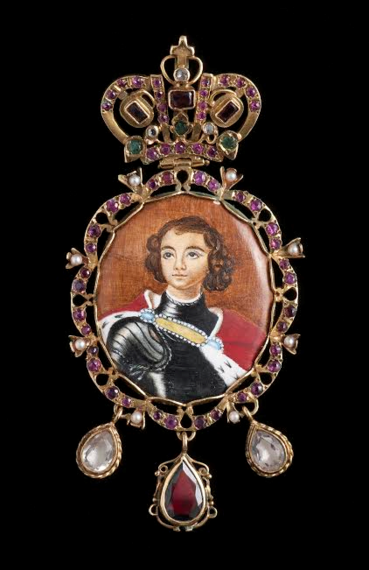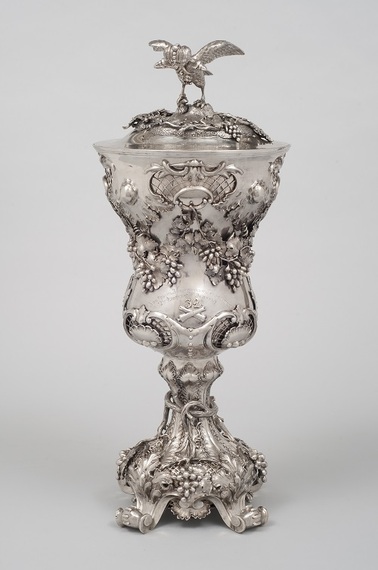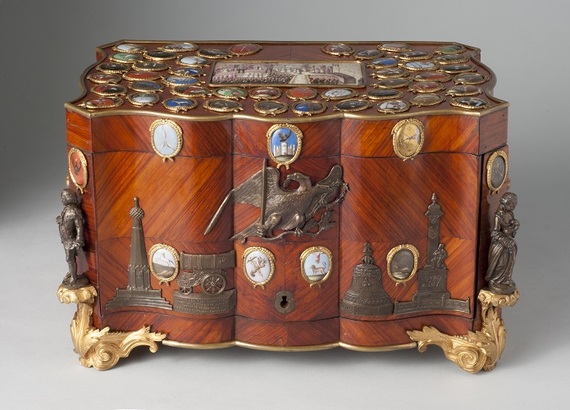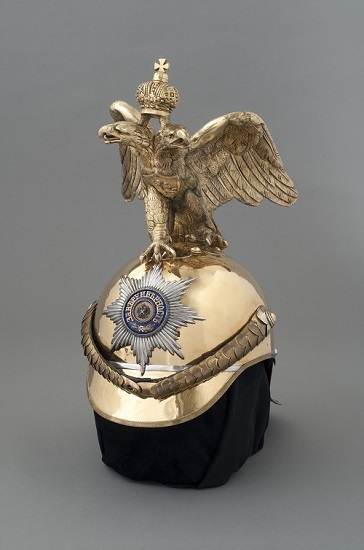From Peter the Great and Catherine the Great to Alexander I and Nicholas II, the Romanovs held onto power with the help of a system of patronage that featured elaborate gifts for military leaders, courtiers, and heads of state. "Gifts and Prayers: The Romanovs and Their Subjects" at the Georgia Museum of Art explores the world that came to a dramatic and violent end a century ago with the Russian Revolution (September 3 to December 31, 2016).
"Gifts and Prayers" brings together nearly 200 objects, part of an extended loan from a promised gift to the museum. Assembled during the Cold War by an Atlanta collector, the collection includes portrait paintings and medallions, colorful pages from coronation albums, and military medals and chivalric orders.
"Gifts to the tsars and from the tsars made of precious materials with symbols of the empire were an important part of maintaining the fabric of Russian society," says curator Asen Kirin, professor of art history at the University of Georgia's Lamar Dodd School of Art. "In the drastically stratified society of the Romanov Empire, the rituals of gift-exchanging affirmed the sense of belonging together."
![]()
Icon of the Mother of God of the Sign with saints, detail, 1875, Tempera on a wooden panel on extended loan to the Georgia Museum of Art from a private collection.
Many of the gifts are engraved with inscriptions in the form of prayers. Drawing on Byzantine tradition, the Romanovs were invested with spiritual authority, responsible for the salvation of their subjects. Russians showed their loyalty to the tsars by praying on their behalf.
Gold, silver and jewels featured prominently in this tradition. After Waterloo, Catherine the Great's beloved grandson Alexander I gave away dozens of silver snuff boxes featuring a battle scene and himself donning a laurel wreath -- a direct copy of a box starring his rival, Napoleon Bonaparte. There are other striking examples -- from a small silver box shaped like the imperial crown that stored silk beauty marks to a spectacular solid silver wreath of silver laurel leaves, berries, and ribbons.

Pin with an enamel miniature portrait of Peter the Great, ca. 1872, Gold, precious stones, pearls, miniature enamel painting.
Peter the Great, who introduced western practices to Russia, appears throughout the show as his successors were clearly hoping that some of his glory would rub off. On the twentieth anniversary of her father's death, Empress Elizabeth commissioned a copy of a famous portrait from her court painter, Pietro Antonio Rotari. Alexander I had himself portrayed in profile facing his illustrious predecessor. For Peter the Great's two hundredth birthday in 1872, Alexander II commissioned a bejeweled pin with an enamel portrait miniature of the tsar.

Ivan Bedniakov (silversmith, active Saint Petersburg 1825-1848), Silver trophy (standing cup), 1856.
Among the show's highlights is an intricately designed silver trophy presented to the commander of an imperial naval unit that defended Sevastopol during the Crimean War. Topped with a two-headed eagle, symbol of the Russian empire, the trophy is decorated with grapes, acanthus leaves, and an inscription from the citizens of Arkhangelsk (After Russia's defeat, its Black Sea fleet was required to disarm and move to the Baltic and North Atlantic). By exposing the weaknesses of the Romanovs and making clear the need for reforms and modernization, the 1856 defeat proved a turning point. The accession of the young, liberal-minded Alexander II was seen as the start of a new era.
In The Decembrists, Leo Tolstoy expressed the sense of optimism at the time: "...all the Russians, as one man, found themselves in indescribable enthusiasm,--a state of things which has been witnessed twice in Russia during the nineteenth century--the first time when in 1812 we thrashed Napoleon I, and the second time when in 1856 Napoleon III thrashed us--great and never-to-be-forgotten epoch of the regeneration of the Russian people. Like that Frenchman, who said that no one had ever lived at all who had not lived during the great French Revolution, so I also do not hesitate to say that anyone who was not living in Russia in the year 1856 does not know what life is."

Presentation cigar box with a coronation scene and coats of arms of provinces, 1856, Rosewood, plain and gilded bronze, brass, enamel miniature painting on copper.
With the 1861 Emancipation Reform, Alexander II finally abolished serfdom, freeing some 23 million Russians. Ironically, two decades later, the reforming tsar was assassinated. His son Alexander III reacted by reversing his father's reforms and ruling Russia in ultra-conservative fashion. Before his accession, Alexander III had commanded St. Petersburg's guards units and led a detachment in the Russo-Turkish War. For his service, Alexander III received the Cross of St. George.
Like other European monarchs, the Romanovs reinforced their power through prestigious orders of chivalry. It was Peter the Great who established the Order of Saint Andrew in 1698 after witnessing award ceremonies for England's Order of the Garter and Austria's Order of the Golden Fleece. There's a full set of regalia on view from the Order of Saint Andrew, considered the apostle who converted Eastern Europe to Christianity. Four ceremonial swords feature insignia of Orders including a diamond-encrusted sword awarded by Alexander I and a curving silver and niello sword from the Caucasus.

Helmet (full dress) of Her Majesty's Horse Guards, late 19th century, Brass, silver, silver gilt, gilt white metal, enamel en plein, enamel over guilloché, silk, leather, cotton fabric on the chinstrap.
In the late 19th century, a member of her Majesty's Horse Guards wore the show's impressive brass and silver full dress helmet, topped with the imperial double-headed eagle and decorated with the star of the Order of Andrew the First-Called. The silver and enamel star is adorned with the "X-shaped" cross of Andrew's martyrdom and the order's motto: "For Faith and Loyalty." A cavalry guard regiment, the chevalier guard regiment had its beginning in a unit founded by Catherine the Great in 1764.
Some five dozen colorful badges and smaller jettons, including several by Faberge, are also on view. Produced by some of the most prominent jewelers in Europe, the gold and silver insignia and orders are embellished with enamel work that includes miniature icons of the orders' patron saints. "The insignia of the orders of chivalry are arguably some of the most symbolically charged works of decorative arts," says Kirin. "The precious materials, the miniature icons, and the expert craftsmanship--all add both monetary and symbolic value to the objects."
Most of the objects in "Gifts and Prayers" had not been previously documented, a fact which led to detective work by Kirin. One of the mysteries centered on the small Portrait of a Youth. An x-ray machine at UGA's College of Veterinary Medicine and multispectral imaging helped authenticate the signature of Aleksei Venetsianov, one of Russia's most significant early 19th-century artists. "This is only the first step in a long-term process of research that will result in the publication of the entire set of 1,226 objects," says Kirin. "Even at this initial step we plan to unwrap the many layers of meaning they convey."
A symposium at the Georgia Museum of Art on September 23 and 24 features a keynote speech by Suzanne Massie and lectures on the history of Russian art collecting in the U.S. For more information, visit http://georgiamuseum.org/art/exhibitions/on-view/gifts-prayer-and-salvation-in-the-romanov-empire
Susan Jaques' biography, The Empress of Art: Catherine the Great and the Transformation of Russia was published in April by Pegasus Books.
